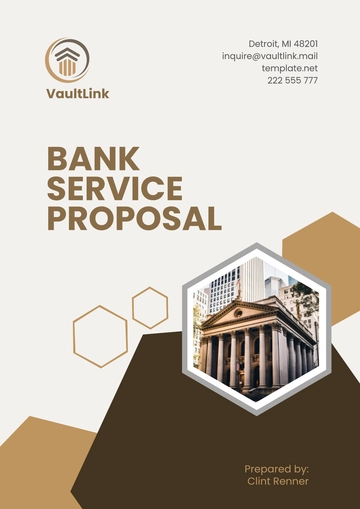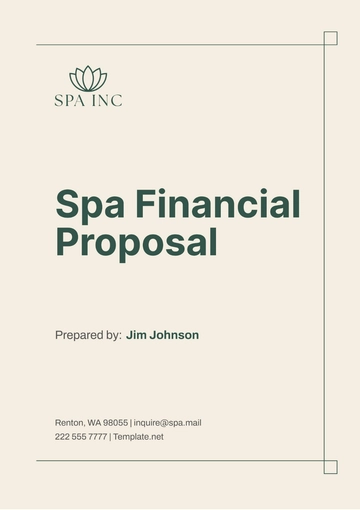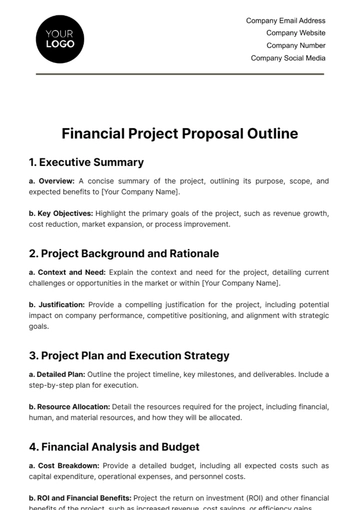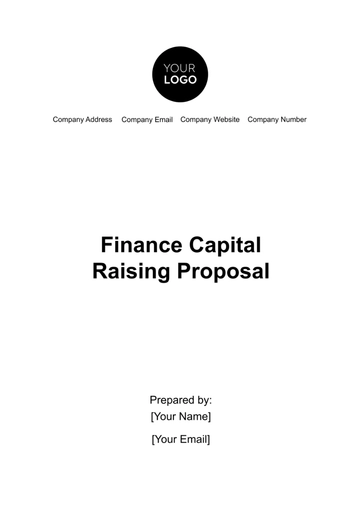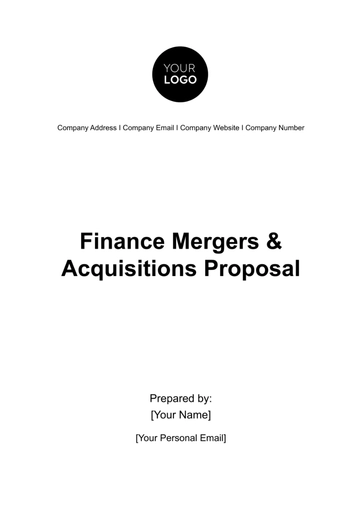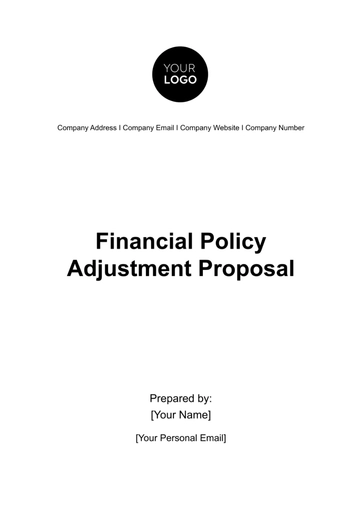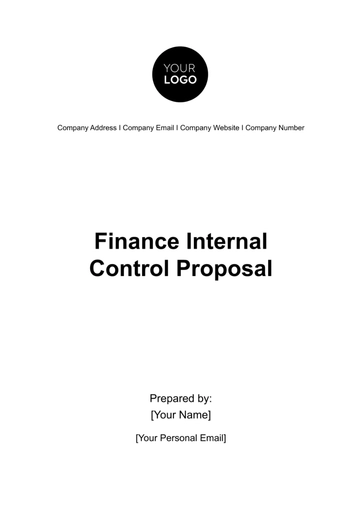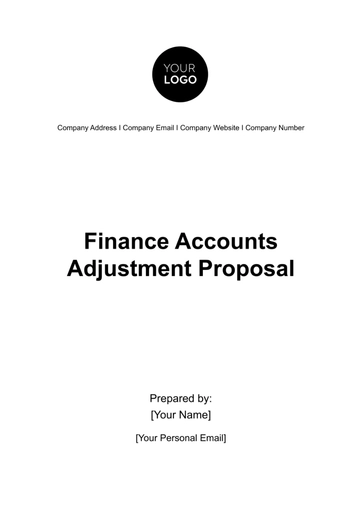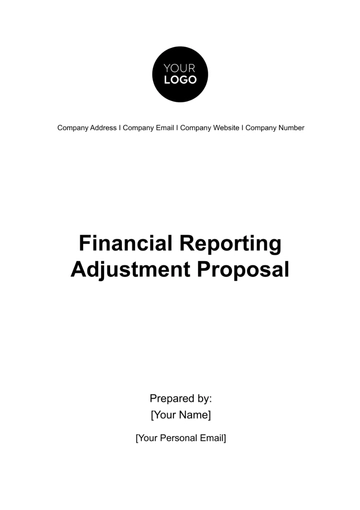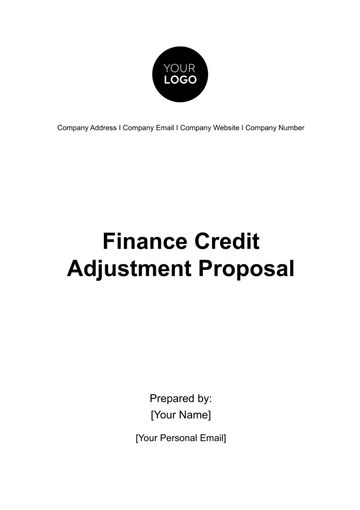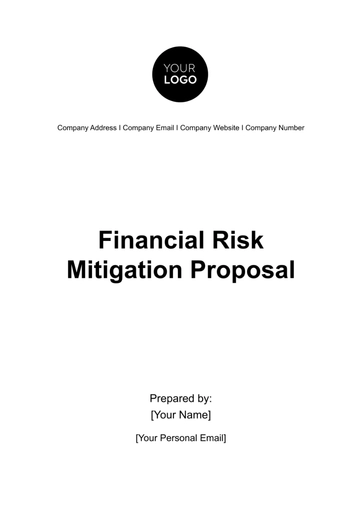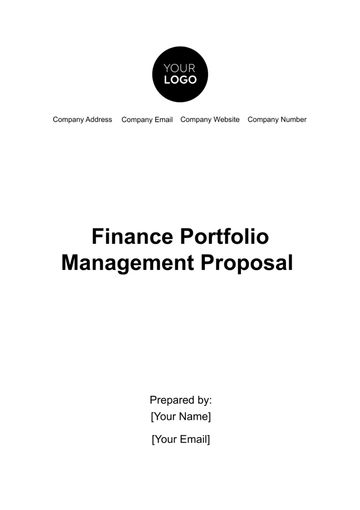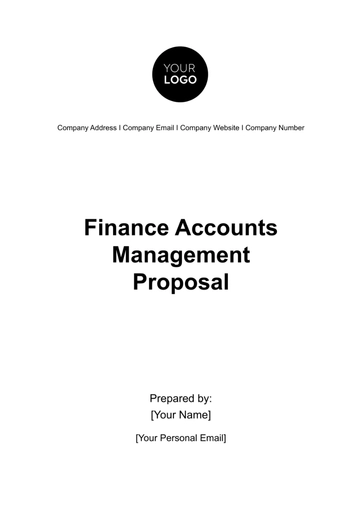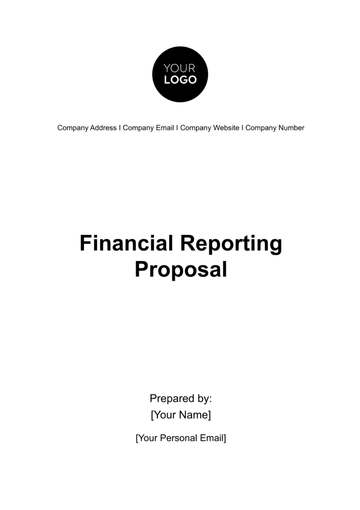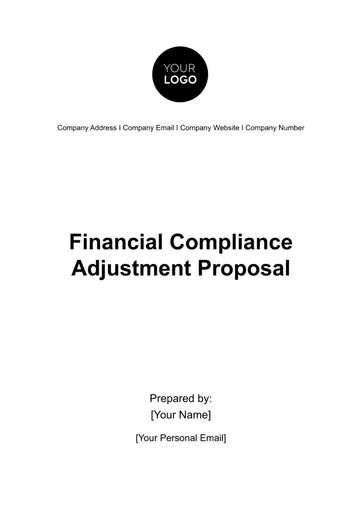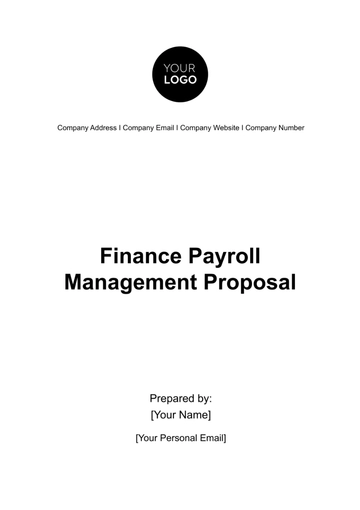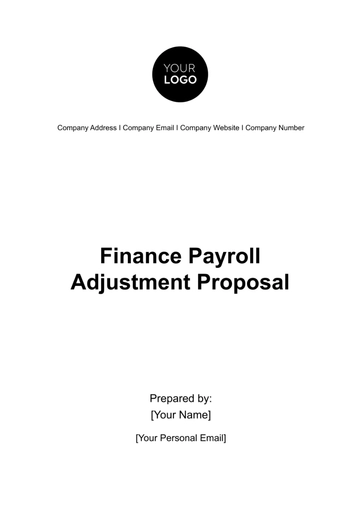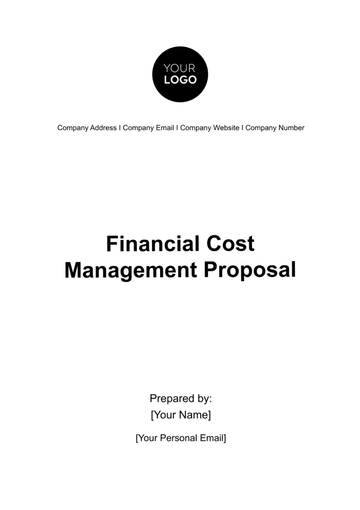Free Finance Mergers & Acquisitions Proposal
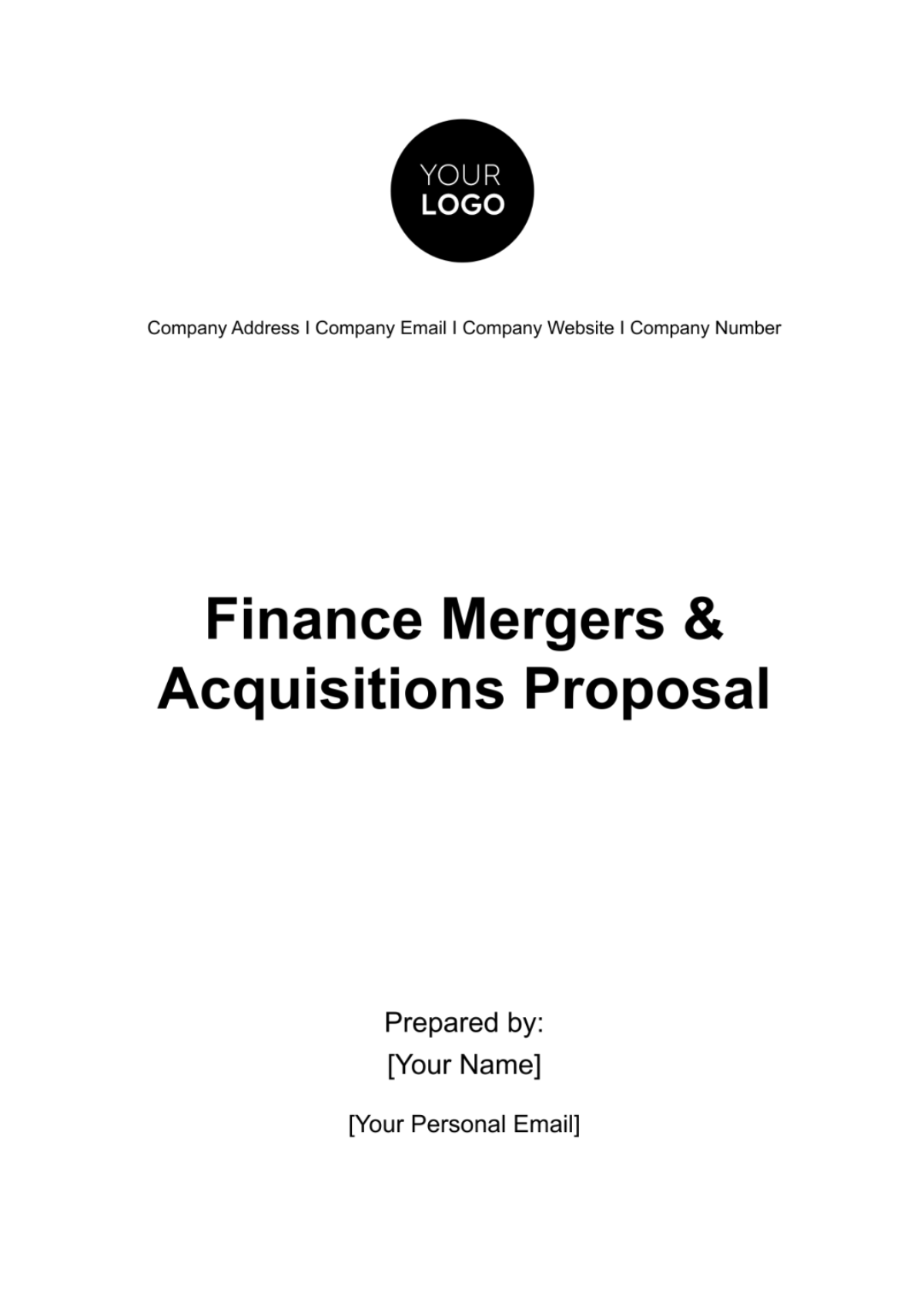
TABLE OF CONTENTS
I. Executive Summary
II. Financial Analysis and Valuation
A. Financial Health Assessment
B. Target Company Valuation
C. Synergy Valuation
III. Deal Structure and Financing
A. Transaction Structure
B. Financing Plan
C. Regulatory Considerations
IV. Integration Plan
A. Operational Integration
B. Cultural Integration
C. Risk Management
V. Conclusion and Next Steps
I. Executive Summary
Overview: This proposal outlines a transformative opportunity for [Your Company Name] to solidify its leadership in the [industry sector] by merging with [Target Company]. This strategic move is not just a growth tactic; it's a leap towards industry dominance. By combining [Your Company Name]'s proven expertise with [Target Company]'s innovative approaches, we envision a future where our joint entity sets new industry benchmarks. This acquisition is a stepping stone towards reshaping the market landscape, promising substantial increases in shareholder value, a broader customer base, and superior operational efficiencies that outpace our competitors.
[Your Company Name] Profile: As a vanguard in the [industry sector], [Your Company Name] stands on a foundation of financial resilience and strategic foresight, boasting a net revenue of $[amount] in the last fiscal year. Our journey has been marked by continuous growth and an unyielding commitment to excellence. We pride ourselves on a diverse portfolio that caters to a wide range of customer needs while maintaining cost-effectiveness and operational superiority. Our ambition is not just to lead but to redefine the standards of our industry. Through strategic expansion, portfolio diversification, and unwavering dedication to cost leadership, we are poised to enter new markets and capture untapped opportunities.
Target Company Profile: [Target Company] emerges as a formidable force in the [industry sector], distinguished by its significant market share and robust financial performance. Their innovative approach to product development and customer engagement makes them an ideal partner for our expansion strategy. With a product line that complements and enhances our own, the merger with [Target Company] represents not just an addition of resources, but a fusion of strengths. This integration promises to unlock new potentials, foster innovation, and create a synergy that will propel us to new heights in our industry.
Strategic Rationale: The strategic merger with [Target Company] is a calculated move aligned with our long-term vision of industry leadership and sustainable growth. This union is expected to unlock significant synergies, including entry into new markets previously untapped by [Your Company Name], achieving substantial cost reductions through streamlined operations, and bolstering our R&D capabilities. This merger is more than just a business decision; it's a transformative strategy designed to forge a path for [Your Company Name] that leads to increased market influence, financial robustness, and a legacy of innovation. It's an opportunity to not only expand our horizons but to set new standards in the [industry sector].
II. Financial Analysis and Valuation
In this critical section, we delve into the financial soundness of [Your Company Name], evaluate the worth of [Target Company], and forecast the synergies arising from this merger. Our analysis hinges on robust financial metrics and valuation models, ensuring a transparent and strategic financial perspective on this proposed merger.
A. Financial Health Assessment
[Your Company Name] exhibits exemplary financial health, underscored by an impressive operating margin of [percentage] and a well-managed debt-to-equity ratio of [ratio]. Our financial prudence is further highlighted by substantial cash reserves and strong credit facilities, which position us in an enviable spot to pursue this ambitious acquisition. This strong financial standing is not just a testament to our past successes but a solid foundation for future ventures, ensuring that we embark on this acquisition journey from a position of strength, without jeopardizing our financial integrity or operational capabilities.
B. Target Company Valuation
In our comprehensive valuation of [Target Company], we applied the rigorous methodologies of Discounted Cash Flow (DCF) and Comparable Company Analysis (CCA), arriving at an estimated valuation of $[amount]. This valuation reflects not just their current financial performance but also encapsulates their future cash flow potential, market standing, and adaptability in the ever-evolving [industry sector] landscape. By accounting for their operational efficiency, market position, and growth trajectory in our valuation, we ensure that our investment is grounded in a realistic assessment of their worth and potential.
C. Synergy Valuation
The merger with [Target Company] is anticipated to unlock significant financial synergies, estimated at approximately $[amount] in cost savings annually. These savings will stem from streamlined operations, unified supply chains, and economies of scale. Additionally, we foresee revenue synergies amounting to $[amount], driven by cross-selling opportunities, expansion of product lines, and tapping into new market segments. These synergies are not mere projections but well-calculated estimates based on strategic planning and market analysis, underscoring the potential of this merger to create a financially robust and market-leading entity.
III. Deal Structure and Financing
This vital section of our proposal lays out the intricate details of the proposed transaction structure, financing plan, and regulatory considerations for the acquisition. It demonstrates [Your Company Name]'s strategic approach in structuring this significant transaction in a way that maximizes value and efficiency while ensuring full compliance with legal and regulatory standards.
A. Transaction Structure
The proposed acquisition structure is a balanced mix of [percentage]% stock and [percentage]% cash. This blend is strategically chosen to optimize the deal for both tax efficiency and shareholder value. It ensures:
Flexibility in financing options, allowing for a dynamic response to market conditions.
Preservation of cash flow for operational needs and future investments.
Minimization of tax liabilities for both entities involved.
Enhancement of shareholder value through a well-thought-out equity deal.
B. Financing Plan
Our financing strategy for this acquisition is meticulously crafted, combining internal resources with external financing to ensure a stable and sustainable financial approach. This plan includes:
Utilization of [Your Company Name]'s internal cash reserves, ensuring a robust initial investment.
Securing a $[amount] credit facility from [Financial Institution] at a favorable interest rate, demonstrating our strong creditworthiness.
Potential for future equity or debt offerings to finance the transaction, keeping our options open for market-responsive maneuvers.
Strategic allocation of resources to maintain operational liquidity and investment in growth areas.
C. Regulatory Considerations
In navigating this acquisition, we are committed to full legal and regulatory compliance, guided by expert legal advice. Our comprehensive approach includes:
Rigorous adherence to antitrust laws, ensuring the merger doesn't create unfair market dominance.
Compliance with all relevant industry-specific regulations, maintaining the integrity of our operational practices.
Coordination with international regulatory bodies, if the acquisition has cross-border implications.
Transparent communication with shareholders, ensuring their informed consent and support for the transaction.
Adherence to financial reporting standards post-acquisition, guaranteeing transparency and accountability.
Through this detailed structuring and financing plan, [Your Company Name] is poised to execute this acquisition efficiently, responsibly, and with a clear focus on long-term value creation.
IV. Integration Plan
This section is dedicated to the comprehensive integration strategy for the merger between [Your Company Name] and [Target Company]. It details the plans for operational, cultural, and risk management integration, aimed at ensuring seamless amalgamation, enhancing efficiency, and mitigating potential challenges.
A. Operational Integration
A detailed integration roadmap has been developed, focusing on aligning IT systems, merging supply chain operations, and consolidating manufacturing units to optimize efficiency.
Component | Strategy |
IT Systems Alignment | Consolidating and standardizing IT infrastructure. Integrating software systems and databases. |
Supply Chain Merging | Synchronizing supply chain networks. Streamlining logistics and distribution channels. |
Manufacturing Consolidation | Unifying manufacturing processes. Optimizing plant locations for efficiency. |
Human Resources Integration | Aligning HR policies and practices. Establishing unified payroll and benefits systems. |
Customer Service Unification | Merging customer support platforms. Standardizing service protocols for consistency. |
B. Cultural Integration
We will implement a comprehensive plan to align corporate cultures, ensuring seamless integration. This includes joint team-building activities, unified communication platforms, and shared corporate values initiatives.
Component | Strategy |
Team-Building Activities | Hosting joint workshops and team events. Encouraging cross-company collaboration projects. |
Unified Communication | Implementing common internal communication platforms. Regular joint updates from leadership. |
Shared Corporate Values | Developing a combined set of core values. Organizing value-based training sessions. |
Employee Exchange Programs | Facilitating temporary job rotations between companies. Promoting knowledge and culture exchange. |
Joint CSR Initiatives | Collaborating on corporate social responsibility projects. Engaging employees in community service. |
C. Risk Management
Key risks identified include operational disruptions and employee retention. Mitigation strategies involve phased integration, clear communication plans, and retention bonuses for key employees.
Risk Factor | Mitigation Strategy |
Operational Disruptions | Implementing phased integration plans. Setting up dedicated integration support teams. |
Employee Retention | Offering retention bonuses and incentives. Conducting regular engagement surveys and feedback sessions. |
Cultural Clashes | Facilitating cultural awareness workshops. Providing counseling and support services. |
IT System Compatibility | Conducting thorough IT system audits. Planning for gradual system integration and support. |
Regulatory Compliance | Keeping abreast of regulatory changes. Ensuring compliance through regular audits and reviews. |
V. Conclusion and Next Steps
This proposal outlines a well-structured and financially sound acquisition of [Target Company], promising substantial value creation for [Your Company Name]. The merger is anticipated to yield significant financial and operational synergies, positioning us as a market leader.
Post-approval, the acquisition process is expected to commence in Q3 [Year], with an anticipated completion by Q2 [Year+1]. Key milestones include due diligence completion, regulatory approvals, and shareholder meetings.
We invite the Board of Directors and key stakeholders of [Your Company Name] to review this proposal in detail. A meeting is scheduled on [Date] to discuss this opportunity further and make informed decisions on the next steps.
- 100% Customizable, free editor
- Access 1 Million+ Templates, photo’s & graphics
- Download or share as a template
- Click and replace photos, graphics, text, backgrounds
- Resize, crop, AI write & more
- Access advanced editor
Introducing Template.net's editable and customizable Finance Mergers & Acquisitions Proposal. Designed by professionals, crafted for strategic value, it's your tool for successful collaborations. It's simple, practical and editable in our Ai Editor Tool. For those aiming high, this is your secret weapon. Elevate your business negotiations elegantly with us.
You may also like
- Business Proposal
- Research Proposal
- Proposal Request
- Project Proposal
- Grant Proposal
- Photography Proposal
- Job Proposal
- Budget Proposal
- Marketing Proposal
- Branding Proposal
- Advertising Proposal
- Sales Proposal
- Startup Proposal
- Event Proposal
- Creative Proposal
- Restaurant Proposal
- Blank Proposal
- One Page Proposal
- Proposal Report
- IT Proposal
- Non Profit Proposal
- Training Proposal
- Construction Proposal
- School Proposal
- Cleaning Proposal
- Contract Proposal
- HR Proposal
- Travel Agency Proposal
- Small Business Proposal
- Investment Proposal
- Bid Proposal
- Retail Business Proposal
- Sponsorship Proposal
- Academic Proposal
- Partnership Proposal
- Work Proposal
- Agency Proposal
- University Proposal
- Accounting Proposal
- Real Estate Proposal
- Hotel Proposal
- Product Proposal
- Advertising Agency Proposal
- Development Proposal
- Loan Proposal
- Website Proposal
- Nursing Home Proposal
- Financial Proposal
- Salon Proposal
- Freelancer Proposal
- Funding Proposal
- Work from Home Proposal
- Company Proposal
- Consulting Proposal
- Educational Proposal
- Construction Bid Proposal
- Interior Design Proposal
- New Product Proposal
- Sports Proposal
- Corporate Proposal
- Food Proposal
- Property Proposal
- Maintenance Proposal
- Purchase Proposal
- Rental Proposal
- Recruitment Proposal
- Social Media Proposal
- Travel Proposal
- Trip Proposal
- Software Proposal
- Conference Proposal
- Graphic Design Proposal
- Law Firm Proposal
- Medical Proposal
- Music Proposal
- Pricing Proposal
- SEO Proposal
- Strategy Proposal
- Technical Proposal
- Coaching Proposal
- Ecommerce Proposal
- Fundraising Proposal
- Landscaping Proposal
- Charity Proposal
- Contractor Proposal
- Exhibition Proposal
- Art Proposal
- Mobile Proposal
- Equipment Proposal
- Student Proposal
- Engineering Proposal
- Business Proposal

